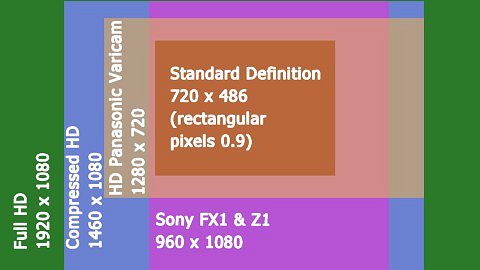Video Content Resolution Guide

Various HD resolutions with the standard definition TV (SD) in the middle.
Pixel resolutions for cameras & compared resolutions for DVD typesStarting resolution of the original video content from HD down to DV. The higher up on the chart below equals higher quality picture and pixel resolution. Aspect Ratio history - Wikipedia Color space
Film ResolutionFilm, on the other hand is not divided up into Luma and color part of the image. The sharpness and color quality is dependent on the type of film. Daylight shots with high-quality film needs 4K of resolution, which is 4096 x 3072 pixels and night shots need half of that.The actual top end of film can go beyond 4K, but it is ascertained that an average audience member, sitting an average distance from the film, cannot make out resolution greater than 4K in daylight scenes. When film is transfered into the digital domain, it is done with the highest resolution possible for both Luma and color. 4K resolution is usually only used when working with digital special effects. The present highest quality HD camera can only capture about 94% of a 2K film transfer. This capture rate was used in the filming of the last 3 episodes of Star Wars. i=interlaced frames, p=progressive and non-interlaced frames. |
|
Format |
Y Luma |
R-Y & Cr |
B-Y & Cb |
35 mm daylight (4k) (some films will be better resolution but telecine uses this resolution to transfer the film to digital in progressive frames.) |
4096 x 3072 |
4096 x 3072 |
4096 x 3072 |
35 mm night (2k used for telecine) progressive frames. |
2048 x 1536 |
2048 x 1536 |
2048 x 1536 |
|
Super 16 mm (2k used for telecine) progressive frames. |
2048 x 1536 |
2048 x 1536 |
2048 x 1536 |
|
HD 4:4:4, 10 bit (Sony F950, Viper Film Stream & Digital data recorders or HDCAM SR tape, 440 MB / sec) suggested for any special effects, blue or green screen |
1920 x 1080 |
1920 x 1080 |
1920 x 1080 |
HD 4:2:2 (Sony F900 to D5 Panasonic VTR 5:1 compression 8 and 10 bit- 220 MB/sec) |
1920 x 1080 |
860 x 590 |
860 x 590 |
|
HD 4:2:2 (Sony F900 compression 8 and 10 bit, HDCAM SR tape- 220 MB/sec) |
1920 x 1080 |
860 x 590 |
860 x 590 |
DVC-Pro HD - 4:2:2 - 100 MB/sec (video compression 6.7:1 with variable frame rates) |
1920 x 1080i 960 x 720p |
960 x 720i 480 x 360p |
960 x 720i 480 x 360p |
HD Panasonic Varicam (compression 6.5:1, 8-bit, variable frame rates.) |
1280 x 720 |
640 x 360 |
640 x 360 |
HDCAM (For presentation, 1440 is expanded to 1920 by software. 3:1:1 - 135 MB/sec) |
1440 x1080 |
480 x 1080 |
- |
HDV (MPEG 2 - compressed 5:1) |
1440 x 1080 |
720 x 590 |
- |
Sony FX1 and Z1 4:2:0 |
960 x 1080 |
480 x 540 |
- |
Digi Beta 4:2:2 (compression 2:1, 10 bit) |
720 x 525 |
360 x 262 |
360 x 262 |
Beta SP (4:2:2 MPEG 2 - analog) |
720 x 525 |
360 x 262 |
360 x 262 |
DVC-Pro 50 (NTSC) |
720 x 480 |
170 x 120 |
170 x 120 |
DV-CAM |
720 x 480 |
170 x 120 |
170 x 120 |
DV (NTSC) |
720 x 480 |
170 x 120 |
- |
For comparison the DVD specs, encoded in MPEG-2, are: |
|||
HD-DVD (Windows Media Codec H.264 VC-9 at 1080p) |
1920 x 1080 |
960 x 540 |
|
HD-DVD (Windows Media Codec H.264 VC-9 at 720p) |
1280 x 720 |
640 x 360 |
|
blu-ray |
1920 x 1080 |
960 x 540 |
|
DVD |
720 x 486 |
360 x 243 |
|